Securing the Forms Authentication Cookie with Secure Flag
Filed under: Development, Security
One of the recommendations for securing cookies within a web application is to apply the Secure attribute. Typically, this is only a browser directive to direct the browser to only include the cookie with a request if it is over HTTPS. This helps prevent the cookie from being sent over an insecure connection, like HTTP. There is a special circumstance around the Microsoft .Net Forms Authentication cookie that I want to cover as it can become a difficult challenge.
The recommended way to set the secure flag on the forms authentication cookie is to set the requireSSL attribute in the web.config as shown below:
<authentication mode="Forms">
<forms name="Test.web" defaultUrl="~/Default" loginUrl="~/Login" path="/" requireSSL="true" protection="All" timeout="20" slidingExpiration="true"/>
</authentication>In the above code, you can see that requireSSL is set to true.
In your login code, you would have code similar to this once the user is properly validated:
FormsAuthentication.SetAuthCookie(userName, false);In this case, the application will automatically set the secure attribute.

Simple, right? In most cases this is very straight forward. Sometimes, it isn’t.
Removing HTTPS on Internal Networks
There are many occasions where the application may remove HTTPS on the internal network. This is commonly seen, or used to be commonly seen, when the application is behind a load balancer. The end user would connect using HTTPS over the internet to the load balancer and then the load balancer would connect to the application server over HTTP. One common reason for this was easier inspection of internal network traffic for monitoring by the organization.
Why Does This Matter? Isn’t the Secure Attribute of a Cookie Browser Only?
There was an interesting decision made by Microsoft when they created .Net Forms Authentication. A decision was made to verify that the connection to the application server is secure if the requireSSL attribute is set on the authentication cookie (specified above in the web.config example), when the cookie is set using FormsAuthentication.SetCookie(). This is the only cookie that the code checks to verify it is on a secure connection.
This means that if you set requireSSL in the web.config for the forms authentication cookie and the request to the server is over HTTP, .Net will throw an exception.
This code can be seen in https://github.com/microsoft/referencesource/blob/master/System.Web/Security/FormsAuthenticationModule.cs in the ExtractTicketFromCookie method:

The obvious solution is to enable HTTPS on the traffic all the way to the application server. But sometimes as developers, we don’t have that control.
What Can We Do?
There are two options I want to discus. This first one actually doesn’t provide a complete solution, even though it seems like it would.
FormsAuthentication.GetAuthCookie
At first glance, FormsAuthentication.GetAuthCookie might seem like a good option. Instead of using SetAuthCookie, which we know will break the application in this case, one might try to call GetAuthCookie and just manage the cookie themselves. Here is what that might look like, once the user is validated.
var cookie = FormsAuthentication.GetAuthCookie(userName, false);
cookie.Secure = true;
HttpContext.Current.Response.Cookies.Add(cookie);Rather than call SetAuthCookie, here we are trying to just get a new AuthCookie and we can set the secure flag and then add it to the cookies collection manually. This is similar to what the SetAuthCookie method does, with the exception that it is not setting the secure flag based on the web.config setting. That is the key difference here.
Keep in mind that GetAuthCookie returns a new auth ticket each time it is called. It does not return the ticket or cookie that was created if you previously called SetAuthCookie.
So why doesn’t this work completely?
Upon initial testing, this method appears to work. If you run the application and log in, you will see that the cookie does have the secure flag set. This is just like our initial response at the beginning of this article. The issue here comes with SlidingExpiration. If you remember, in our web.config, we had SlidingExpiration set to true (the default is true, so it was set in the config just for visual aide).
<authentication mode="Forms">
<forms name="Test.web" defaultUrl="~/Default" loginUrl="~/Login" path="/" requireSSL="true" protection="All" timeout="20" slidingExpiration="true"/>
</authentication>Sliding expiration means that once the ticket is reached over 1/2 of its age and is submitted with a request, it will auto renew. This allows a user that is active to not have to re-authentication after the timeout. This re-authentication occurs again in https://github.com/microsoft/referencesource/blob/master/System.Web/Security/FormsAuthenticationModule.cs in the OnAuthenticate method.

We can see in the above code that the secure flag is again being set by the FormsAuthentication.RequireSSL web.config setting. So even though we jumped through some hoops to set it manually during the initial authentication, every ticket renewal will reset it back to the config setting.
In our web.config we had a timeout set to 20 minutes. So requesting a page after 12 minutes will result in the application setting a new FormsAuth cookie without the Secure attribute.
This option would most likely get scanners and initial testers to believe the problem was remediated. However, after a potentially short period of time (depending on your timeout setting), the cookie becomes insecure again. I don’t recommend trying to set the secure flag in this manner.
Option 2 – Global.asax
Another option is to use the Global.asax Application_EndRequest event to set the cookie to secure. With this configuration, the web.config would not set requireSSL to true and the authentication would just use the FormsAuthentication.SetAuthCookie() method. Then, in the Global.asax file we could have something similar to the following code.
protected void Application_EndRequest(object sender, EventArgs e)
{
if(Response.Cookies.Count > 0)
{
for(int i = 0; i < Response.Cookies.Count; i++)
{
//Response.Cookies[i].Secure = true;
}
}
}The above code will loop through all the cookies setting the secure flag on them on every request. It is possible to go one step further and check the cookie name to see if it matches the forms authentication cookie before setting the secure flag, but hopefully your site runs on HTTPS so there should be no harm in all cookies having the secure flag set.
There have been debate on how well this method works based on when the EndRequest event will fire and if it fires for all requests or not. In my local testing, this method appears to work and the secure flag is set properly. However, that was local testing with minimal traffic. I cannot verify the effectiveness on a site with heavy loads or load balancing or other configurations. I recommend testing this out thoroughly before using it.
Conclusion
For something that should be so simple, this situation can be a headache for developers that don’t have any control over the connection to their application. In the end, the ideal situation would be to enable HTTPS to the application server so the requireSSL flag can be set in the web.config. If that is not possible, then there are some workarounds that will hopefully work. Make sure you are doing the appropriate testing to verify the workaround works 100% of the time and not just once or twice. Otherwise, you may just be checking a box to show an example of it being marked secure, when it is not in all cases.
What is the difference between encryption and hashing?
Filed under: Development, Security
Encryption is a reversible process, whereas hashing is one-way only. Data that has been encrypted can be decrypted back to the original value. Data that has been hashed cannot be transformed back to its original value.
Encryption is used to protect sensitive information like Social Security Numbers, credit card numbers or other sensitive information that may need to be accessed at some point.
Hashing is used to create data signatures or comparison only features. For example, user passwords used for login should be hashed because the program doesn’t need to store the actual password. When the user attempts to log in, the system will generate a hash of the supplied password using the same technique as the one stored and compare them. If they match, the passwords are the same.
Another example scenario with hashing is with file downloads to verify integrity. The supplier of the file will create a hash of the file on the server so when you download the file you can then generate the hash locally and compare them to make sure the file is correct.
JavaScript in an HREF or SRC Attribute
Filed under: Development, Security, Testing
The anchor (<a>) HTML tag is commonly used to provide a clickable link for a user to navigate to another page. Did you know it is also possible to set the HREF attribute to execute JavaScript. A common technique is to use the onclick event of the anchor tab to execute a JavaScript method when the user clicks the link. However, to stop the browser from actually redirecting the HREF can be set to javascript:void(0);. This cancels the HREF functionality and allows the JavaScript from the onclick to execute as expected.
In the above example, notice that the HREF is set with a value starting with “javascript:”. This identifier tells the browser to execute the code following that prefix. For those that are security savvy, you might be thinking about cross-site scripting when you hear about executing JavaScript within the browser. For those of you that are new to security, cross-site scripting refers to the ability for an attacker to execute unintended JavaScript in the context of your application (https://www.owasp.org/index.php/Cross-site_Scripting_(XSS)).
I want to walk through a simple scenario of where this could be abused. In this scenario, the application will attempt to track the page the user came from to set up where the Cancel button will redirect to. Imagine you have a list page that allows you to view details of a specific item. When you click the item it takes you to that item page and passes a BackUrl in the query string. So the link may look like:
https://jardinesoftware.com/item.php?backUrl=/items.php
On the page, there is a hyperlink created that sets the HREF to the backUrl property, like below:
<a href=”<?php echo $_GET[“backUrl”];?>”>Back</a>
When the page executes as expected you should get an output like this:
<a href=”/items.php”>Back</a>
There is a big problem though. The application is not performing any type of output encoding to protect against cross-site scripting. If we instead pass in backUrl=”%20onclick=”alert(10); we will get the following output:
<a href=”” onclick=”alert(10);“>Back</a>
In the instance above, we have successfully inserted the onclick event by breaking out of the HREF attribute. The bold section identifies the malicious string we added. When this link is clicked it will prompt an alert box with the number 10.
To remedy this, we could (or typically) use output encoding to block the escape from the HREF attribute. For example, if we can escape the double quotes (” -> " then we cannot get out of the HREF attribute. We can do this (in PHP as an example) using htmlentities() like this:
<a href=”<?php echo htmlentities($_GET[“backUrl”],ENT_QUOTES);?>”>Back</a>
When the value is rendered the quotes will be escapes like the following:
<a href=”" onclick=&"alert(10);“>Back</a>
Notice in this example, the HREF actually has the entire input (in bold), rather than an onclick event actually being added. When the user clicks the link it will try to go to https://www.developsec.com/” onclick=”alert(10); rather than execute the JavaScript.
But Wait… JavaScript
It looks like we have solved the XSS problem, but there is a piece still missing. Remember at the beginning of the post how we mentioned the HREF supports the javascript: prefix? That will allow us to bypass the current encodings we have performed. This is because with using the javascript: prefix, we are not trying to break out of the HREF attribute. We don’t need to break out of the double quotes to create another attribute. This time we will set backUrl=javascript:alert(11); and we can see how it looks in the response:
<a href=”javascript:alert(11);“>Back</a>
When the user clicks on the link, the alert will trigger and display on the page. We have successfully bypassed the XSS protection initially put in place.
Mitigating the Issue
There are a few steps we can take to mitigate this issue. Each has its pros and many can be used in conjunction with each other. Pick the options that work best for your environment.
- URL Encoding – Since the HREF is meant to be a URL, you could perform URL encoding. URL encoding will render the javascript benign in the above instances because the colon (:) will get encoded. You should be using URL encoding for URLs anyway, right?
- Implement Content Security Policy (CSP) – CSP can help limit the ability for inline scripts to be executed. In this case, it is an inline script so something as simple as ‘Content-Security-Policy:default-src ‘self’ could be sufficient. Of course, implementing CSP requires research and great care to get it right for your application.
- Validate the URL – It is a good idea to validate that the URL used is well formed and pointing to a relative path. If the system is unable to parse the URL then it should not be used and a default back URL can be substituted.
- URL White Listing – Creating a white list of valid URLs for the back link can be effective at limiting what input is used by the end user. This can cut down on the values that are actually returned blocking any malicious scripts.
- Remove javascript: – This really isn’t recommended as different encodings can make it difficult to effectively remove the string. The other techniques listed above are much more effective.
The above list is not exhaustive, but does give an idea of ways to help reduce the risk of JavaScript within the HREF attribute of a hyper link.
Iframe SRC
It is important to note that this situation also applies to the IFRAME SRC attribute. it is possible to set the SRC of an IFRAME using the javascript: notation. In doing so, the javascript executes when the page is loaded.
Wrap Up
When developing applications, make sure you take this use case into consideration if you are taking URLs from user supplied input and setting that in an anchor tag or IFrame SRC.
If you are responsible for testing applications, take note when you identify URLs in the parameters. Investigate where that data is used. If you see it is used in an anchor tag, look to see if it is possible to insert JavaScript in this manner.
For those performing static analysis or code review, look for areas where the HREF or SRC attributes are set with untrusted data and make sure proper encoding has been applied. This is less of a concern if the base path of the URL has been hard-coded and the untrusted input only makes up parameters of the URL. These should still be properly encoded.
SQL Injection: Calling Stored Procedures Dynamically
Filed under: Development, Security, Testing
It is not news that SQL Injection is possible within a stored procedure. There have been plenty of articles discussing this issues. However, there is a unique way that some developers execute their stored procedures that make them vulnerable to SQL Injection, even when the stored procedure itself is actually safe.
Look at the example below. The code is using a stored procedure, but it is calling the stored procedure using a dynamic statement.
conn.Open();
var cmdText = "exec spGetData '" + txtSearch.Text + "'";
SqlDataAdapter adapter = new SqlDataAdapter(cmdText, conn);
DataSet ds = new DataSet();
adapter.Fill(ds);
conn.Close();
grdResults.DataSource = ds.Tables[0];
grdResults.DataBind();
It doesn’t really matter what is in the stored procedure for this particular example. This is because the stored procedure is not where the injection is going to occur. Instead, the injection occurs when the EXEC statement is concatenated together. The email parameter is being dynamically added in, which we know is bad.
This can be quickly tested by just inserting a single quote (‘) into the search field and viewing the error message returned. It would look something like this:
System.Data.SqlClient.SqlException (0x80131904): Unclosed quotation mark after the character string ”’. at System.Data.SqlClient.SqlConnection.OnError(SqlException exception, Boolean breakConnection, Action`1 wrapCloseInAction) at System.Data.SqlClient.SqlInternalConnection.OnError(SqlException exception, Boolean breakConnection, Action`1 wrapCloseInAction) at System.Data.SqlClient.TdsParser.ThrowExceptionAndWarning(TdsParserStateObject stateObj, Boolean callerHasConnectionLock, Boolean asyncClose) at System.Data.SqlClient.TdsParser.TryRun(RunBehavior runBehavior, SqlCommand cmdHandler, SqlDataReader dataStream, BulkCopySimpleResultSet bulkCopyHandler, TdsParserStateObject stateObj, Boolean& dataReady) at System.Data.SqlClient.SqlDataReader.TryConsumeMetaData() at System.Data.SqlClient.SqlDataReader.get_MetaData() at
With a little more probing, it is possible to get more information leading us to understand how this SQL is constructed. For example, by placing ‘,’ into the search field, we see a different error message:
System.Data.SqlClient.SqlException (0x80131904): Procedure or function spGetData has too many arguments specified. at System.Data.SqlClient.SqlConnection.
The mention of the stored procedure having too many arguments helps identify this technique for calling stored procedures.
With SQL we have the ability to execute more than one query in a given transaction. In this case, we just need to break out of the current exec statement and add our own statement. Remember, this doesn’t effect the execution of the spGetData stored procedure. We are looking at the ability to add new statements to the request.
Lets assume we search for this:
james@test.com’;SELECT * FROM tblUsers–
this would change our cmdText to look like:
exec spGetData’james@test.com’;SELECT * FROM tblUsers–‘
The above query will execute the spGetData stored procedure and then execute the following SELECT statement, ultimately returning 2 result sets. In many cases, this is not that useful for an attacker because the second table would not be returned to the user. However, this doesn’t mean that this makes an attack impossible. Instead, this turns our attacks more towards what we can Do, not what can we receive.
At this point, we are able to execute any commands against the SQL Server that the user has permission too. This could mean executing other stored procedures, dropping or modifying tables, adding records to a table, or even more advanced attacks such as manipulating the underlying operating system. An example might be to do something like this:
james@test.com’;DROP TABLE tblUsers–
If the user has permissions, the server would drop tblUsers, causing a lot of problems.
When calling stored procedures, it should be done using command parameters, rather than dynamically. The following is an example of using proper parameters:
conn.Open();
SqlCommand cmd = new SqlCommand();
cmd.CommandText = "spGetData";
cmd.CommandType = CommandType.StoredProcedure;
cmd.Connection = conn;
cmd.Parameters.AddWithValue("@someData", txtSearch.Text);
SqlDataAdapter adapter = new SqlDataAdapter(cmd);
DataSet ds = new DataSet();
adapter.Fill(ds);
conn.Close();
grdResults.DataSource = ds.Tables[0];
grdResults.DataBind();
The code above adds parameters to the command object, removing the ability to inject into the dynamic code.
It is easy to think that because it is a stored procedure, and the stored procedure may be safe, that we are secure. Unfortunately, simple mistakes like this can lead to a vulnerability. Make sure that you are properly making database calls using parameterized queries. Don’t use dynamic SQL, even if it is to call a stored procedure.
XXE and .Net
XXE, or XML External Entity, is an attack against applications that parse XML. It occurs when XML input contains a reference to an external entity that it wasn’t expected to have access to. Through this article, I will discuss how .Net handles XML for certain objects and how to properly configure these objects to block XXE attacks. It is important to understand that the different versions of the .Net framework handle this differently. I will point out the differences for each object.
I will cover the XmlReader, XmlTextReader, and XMLDocument. Here is a quick summary regarding the default settings:
| Object | Safe by Default? |
|---|---|
| XmlReader | |
| Prior to 4.0 | Yes |
| 4.0 + | Yes |
| XmlTextReader | |
| Prior to 4.0 | No |
| 4.0 + | No |
| XmlDocument | |
| 4.5 and Earlier | No |
| 4.6 | Yes |
XMLReader
Prior to 4.0
The ProhibitDtd property is used to determine if a DTD will be parsed.
- True (default) – throws an exception if a DTD is identified. (See Figure 1)
- False – Allows parsing the DTD. (Potentially Vulnerable)
Code that throws an exception when a DTD is processed: – By default, ProhibitDtd is set to true and will throw an exception when an Entity is referenced.
static void Reader()
{
string xml = "<?xml version=\"1.0\" ?><!DOCTYPE doc
[<!ENTITY win SYSTEM \"file:///C:/Users/user/Documents/testdata2.txt\">]
><doc>&win;</doc>";
XmlReader myReader = XmlReader.Create(new StringReader(xml));
while (myReader.Read())
{
Console.WriteLine(myReader.Value);
}
Console.ReadLine();
}
Exception when executed:
[Figure 1]
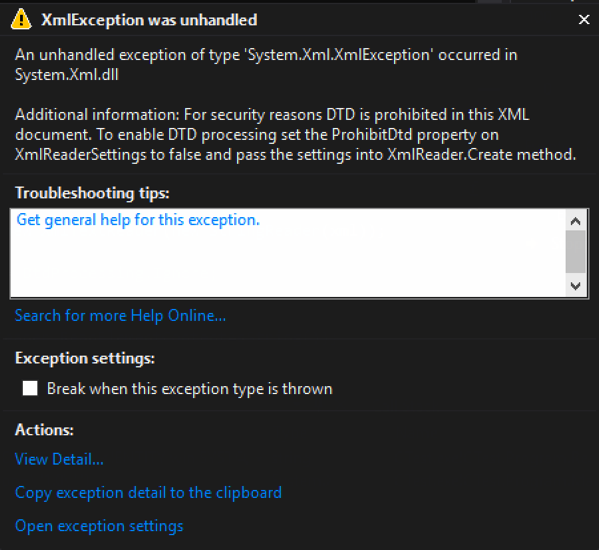
Code that allows a DTD to be processed: – Using the XmlReaderSettings object, it is possible to allow the parsing of the entity. This could make your application vulnerable to XXE.
static void Reader()
{
string xml = "<?xml version=\"1.0\" ?><!DOCTYPE doc
[<!ENTITY win SYSTEM \"file:///C:/Users/user/Documents/testdata2.txt\">]
><doc>&win;</doc>";
XmlReaderSettings rs = new XmlReaderSettings();
rs.ProhibitDtd = false;
XmlReader myReader = XmlReader.Create(new StringReader(xml),rs);
while (myReader.Read())
{
Console.WriteLine(myReader.Value);
}
Console.ReadLine();
}
Output when executed showing injected text:
[Figure 2]
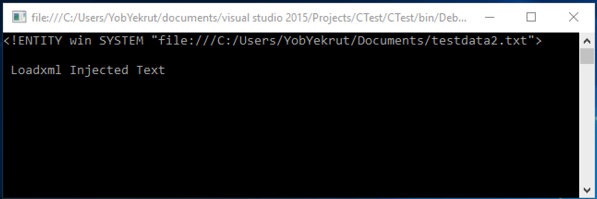
.Net 4.0+
In .Net 4.0, they made a change from using the ProhibitDtD property to the new DtdProcessing enumeration. There are now three (3) options:
- Prohibit (default) – Throws an exception if a DTD is identified.
- Ignore – Ignores any DTD specifications in the document, skipping over them and continues processing the document.
- Parse – Will parse any DTD specifications in the document. (Potentially Vulnerable)
Code that throws an exception when a DTD is processed: – By default, the DtdProcessing is set to Prohibit, blocking any external entities and creating safe code.
static void Reader()
{
string xml = "<?xml version=\"1.0\" ?><!DOCTYPE doc
[<!ENTITY win SYSTEM \"file:///C:/Users/user/Documents/testdata2.txt\">]
><doc>&win;</doc>";
XmlReader myReader = XmlReader.Create(new StringReader(xml));
while (myReader.Read())
{
Console.WriteLine(myReader.Value);
}
Console.ReadLine();
}
Exception when executed:
[Figure 3]
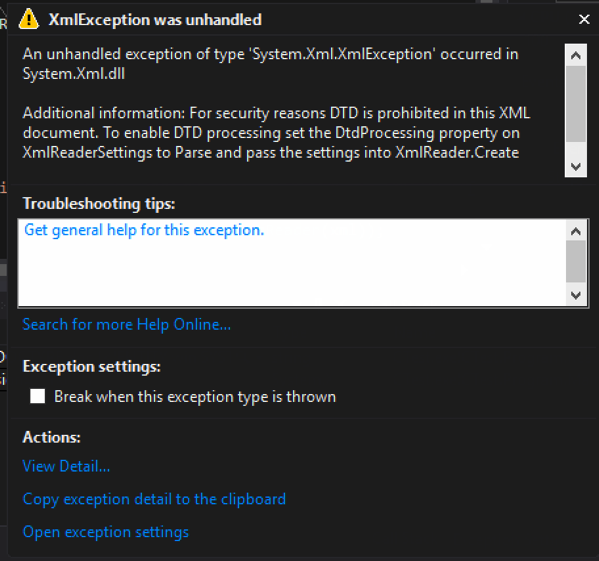
Code that ignores DTDs and continues processing: – Using the XmlReaderSettings object, setting DtdProcessing to Ignore will skip processing any entities. In this case, it threw an exception because there was a reference to the entirety that was skipped.
static void Reader()
{
string xml = "<?xml version=\"1.0\" ?><!DOCTYPE doc
[<!ENTITY win SYSTEM \"file:///C:/Users/user/Documents/testdata2.txt\">]
><doc>&win;</doc>";
XmlReaderSettings rs = new XmlReaderSettings();
rs.DtdProcessing = DtdProcessing.Ignore;
XmlReader myReader = XmlReader.Create(new StringReader(xml),rs);
while (myReader.Read())
{
Console.WriteLine(myReader.Value);
}
Console.ReadLine();
}
Output when executed ignoring the DTD (Exception due to trying to use the unprocessed entity):
[Figure 4]
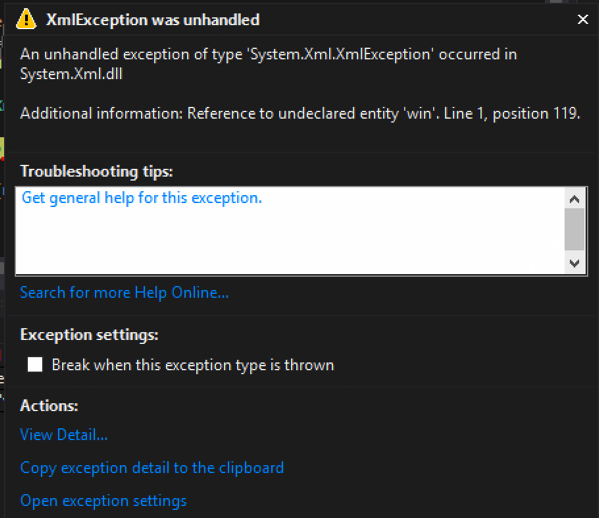
Code that allows a DTD to be processed: Using the XmlReaderSettings object, setting DtdProcessing to Parse will allow processing the entities. This potentially makes your code vulnerable.
static void Reader()
{
string xml = "<?xml version=\"1.0\" ?><!DOCTYPE doc
[<!ENTITY win SYSTEM \"file:///C:/Users/user/Documents/testdata2.txt\">]
><doc>&win;</doc>";
XmlReaderSettings rs = new XmlReaderSettings();
rs.DtdProcessing = DtdProcessing.Parse;
XmlReader myReader = XmlReader.Create(new StringReader(xml),rs);
while (myReader.Read())
{
Console.WriteLine(myReader.Value);
}
Console.ReadLine();
}
Output when executed showing injected text:
[Figure 5]
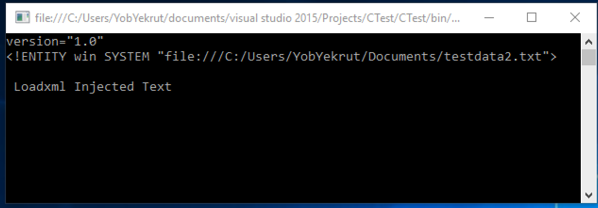
XmlTextReader
The XmlTextReader uses the same properties as the XmlReader object, however there is one big difference. The XmlTextReader defaults to parsing XML Entities so you need to explicitly tell it not too.
Prior to 4.0
The ProhibitDtd property is used to determine if a DTD will be parsed.
- True – throws an exception if a DTD is identified. (See Figure 1)
- False (Default) – Allows parsing the DTD. (Potentially Vulnerable)
Code that allows a Dtd to be processed: (Potentially Vulnerable) – By default, the XMLTextReader sets the ProhibitDtd property to False, allowing entities to be parsed and the code to potentially be vulnerable.
static void TextReader()
{
string xml = "<?xml version=\"1.0\" ?><!DOCTYPE doc
[<!ENTITY win SYSTEM \"file:///C:/Users/user/Documents/testdata2.txt\">]
><doc>&win;</doc>";
XmlTextReader myReader = new XmlTextReader(new StringReader(xml));
while (myReader.Read())
{
if (myReader.NodeType == XmlNodeType.Element)
{
Console.WriteLine(myReader.ReadElementContentAsString());
}
}
Console.ReadLine();
}
Code that blocks the Dtd from being parsed and throws an exception: – Setting the ProhibitDtd property to true (explicitly) will block Dtds from being processed making the code safe from XXE. Notice how the XmlTextReader has the ProhibitDtd property directly, it doesn’t have to use the XmlReaderSettings object.
static void TextReader()
{
string xml = "<?xml version=\"1.0\" ?><!DOCTYPE doc
[<!ENTITY win SYSTEM \"file:///C:/Users/user/Documents/testdata2.txt\">]
><doc>&win;</doc>";
XmlTextReader myReader = new XmlTextReader(new StringReader(xml));
myReader.ProhibitDtd = true;
while (myReader.Read())
{
if (myReader.NodeType == XmlNodeType.Element)
{
Console.WriteLine(myReader.ReadElementContentAsString());
}
}
Console.ReadLine();
}
4.0+
In .Net 4.0, they made a change from using the ProhibitDtD property to the new DtdProcessing enumeration. There are now three (3) options:
- Prohibit – Throws an exception if a DTD is identified.
- Ignore – Ignores any DTD specifications in the document, skipping over them and continues processing the document.
- Parse (Default) – Will parse any DTD specifications in the document. (Potentially Vulnerable)
Code that allows a DTD to be processed: (Vulnerable) – By default, the XMLTextReader sets the DtdProcessing to Parse, making the code potentially vulnerable to XXE.
static void TextReader()
{
string xml = "<?xml version=\"1.0\" ?><!DOCTYPE doc
[<!ENTITY win SYSTEM \"file:///C:/Users/user/Documents/testdata2.txt\">]
><doc>&win;</doc>";
XmlTextReader myReader = new XmlTextReader(new StringReader(xml));
while (myReader.Read())
{
if (myReader.NodeType == XmlNodeType.Element)
{
Console.WriteLine(myReader.ReadElementContentAsString());
}
}
Console.ReadLine();
}
Code that blocks the Dtd from being parsed: – To block entities from being parsed, you must explicitly set the DtdProcessing property to Prohibit or Ignore. Note that this is set directly on the XmlTextReader and not through the XmlReaderSettings object.
static void TextReader()
{
string xml = "<?xml version=\"1.0\" ?><!DOCTYPE doc
[<!ENTITY win SYSTEM \"file:///C:/Users/user/Documents/testdata2.txt\">]
><doc>&win;</doc>";
XmlTextReader myReader = new XmlTextReader(new StringReader(xml));
myReader.DtdProcessing = DtdProcessing.Prohibit;
while (myReader.Read())
{
if (myReader.NodeType == XmlNodeType.Element)
{
Console.WriteLine(myReader.ReadElementContentAsString());
}
}
Console.ReadLine();
}
Output when Dtd is prohibited:
[Figure 6]
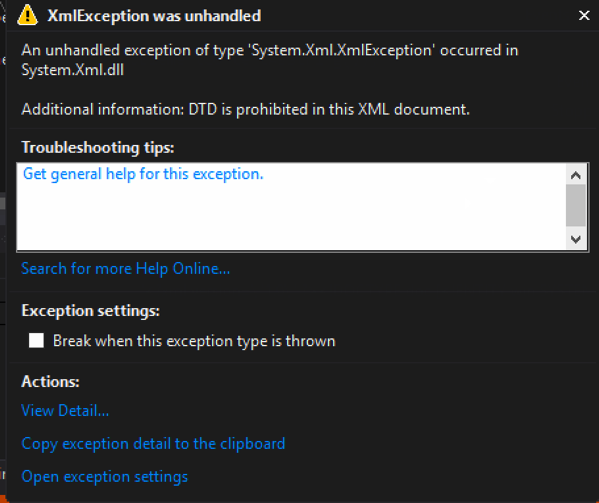
XMLDocument
For the XMLDocument, you need to change the default XMLResolver object to prohibit a Dtd from being parsed.
.Net 4.5 and Earlier
By default, the XMLDocument sets the URLResolver which will parse Dtds included in the XML document. To prohibit this, set the XmlResolver = null.
Code that does not set the XmlResolver properly (potentially vulnerable) – The default XMLResolver will parse entities, making the following code potentially vulnerable.
static void Load()
{
string fileName = @"C:\Users\user\Documents\test.xml";
XmlDocument xmlDoc = new XmlDocument();
xmlDoc.Load(fileName);
Console.WriteLine(xmlDoc.InnerText);
Console.ReadLine();
}
Code that does set the XmlResolver to null, blocking any Dtds from executing: – To block entities from being parsed, you must explicitly set the XmlResolver to null. This example uses LoadXml instead of Load, but they both work the same in this case.
static void LoadXML()
{
string xml = "<?xml version=\"1.0\" ?><!DOCTYPE doc
[<!ENTITY win SYSTEM \"file:///C:/Users/user/Documents/testdata2.txt\">]
><doc>&win;</doc>";
XmlDocument xmlDoc = new XmlDocument();
xmlDoc.XmlResolver = null;
xmlDoc.LoadXml(xml);
Console.WriteLine(xmlDoc.InnerText);
Console.ReadLine();
}
.Net 4.6
It appears that in .Net 4.6, the XMLResolver is defaulted to Null, making the XmlDocument safe. However, you can still set the XmlResolver in a similar way as prior to 4.6 (see previous code snippet).
.Net EnableHeaderChecking
How often do you take untrusted input and insert it into response headers? This could be in a custom header or in the value of a cookie. Untrusted user data is always a concern when it comes to the security side of application development and response headers are no exception. This is referred to as Response Splitting or HTTP Header Injection.
Like Cross Site Scripting (XSS), HTTP Header Injection is an attack that results from untrusted data being used in a response. In this case, it is in a response header which means that the context is what we need to focus on. Remember that in XSS, context is very important as it defines the characters that are potentially dangerous. In the HTML context, characters like < and > are very dangerous. In Header Injection the greatest concern is over the carriage return (%0D or \r) and new line (%0A or \n) characters, or CRLF. Response headers are separated by CRLF, indicating that if you can insert a CRLF then you can start creating your own headers or even page content.
Manipulating the headers may allow you to redirect the user to a different page, perform cross-site scripting attacks, or even rewrite the page. While commonly overlooked, this is a very dangerous flaw.
ASP.Net has a built in defense mechanism that is enabled by default called EnableHeaderChecking. When EnableHeaderChecking is enabled, CRLF characters are converted to %0D%0A and the browser does not recognize it as a new line. Instead, it is just displayed as characters, not actually creating a line break. The following code snippet was created to show how the response headers look when adding CRLF into a header.
public partial class _Default : Page
{
protected void Page_Load(object sender, EventArgs e)
{
Response.AppendHeader("test", "tes%0D%0At\r\ntest2");
Response.Cookies.Add(new HttpCookie("Test-Cookie", "Another%0D%0ATest\r\nCookie"));
}
}
When the application runs, it will properly encode the CRLF as shown in the image below.
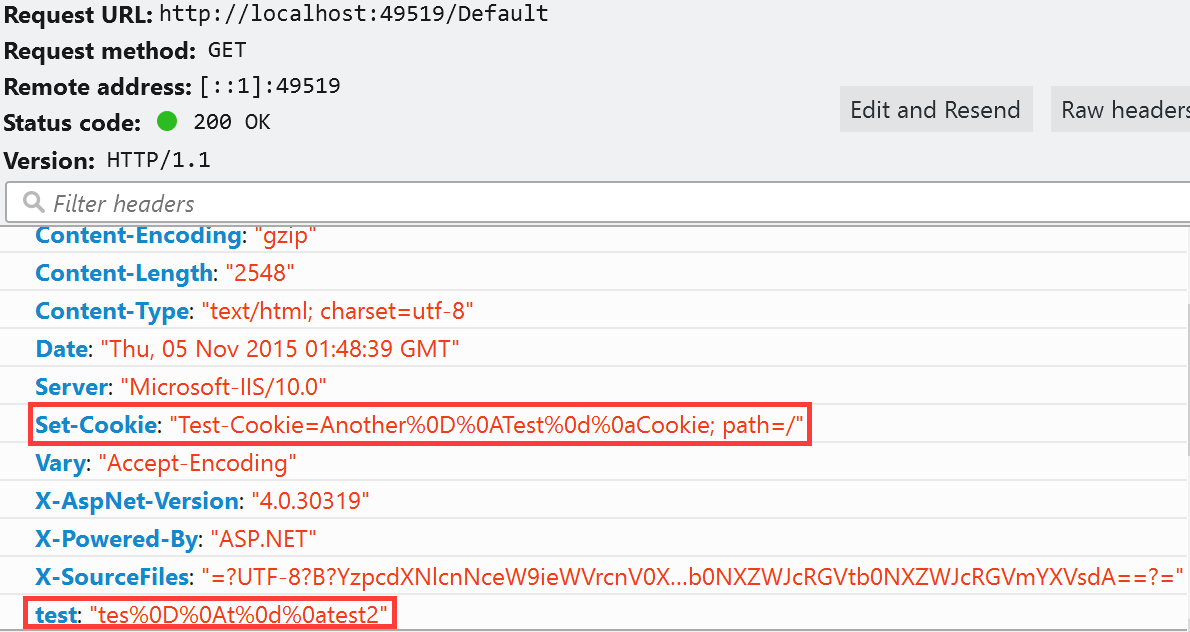
My next step was to disable EnableHeaderChecking in the web.config file.
<httpRuntime targetFramework="4.6" enableHeaderChecking="false"/>
My expectation was that I would get a response that allowed the CRLF and would show me a line break in the response headers. To my surprise, I got the error message below:
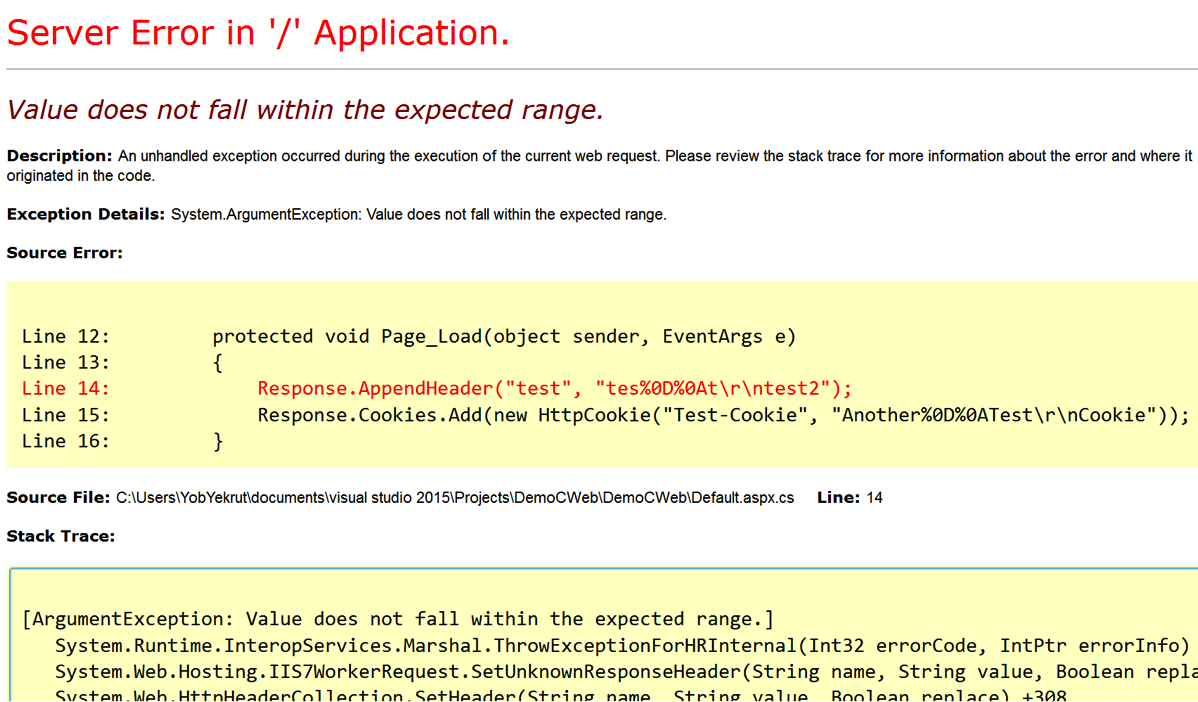
So why the error? After doing a little Googling I found an article about ASP.Net 2.0 Breaking Changes on IIS 7.0. The item of interest is “13. IIS always rejects new lines in response headers (even if ASP.NET enableHeaderChecking is set to false)”
I didn’t realize this change had been implemented, but apparently, if using IIS 7.0 or above, ASP.Net won’t allow newline characters in a response header. This is actually good news as there is very little reason to allow new lines in a response header when if that was required, just create a new header. This is a great mitigation and with the default configuration helps protect ASP.Net applications from Response Splitting and HTTP Header Injection attacks.
Understanding the framework that you use and the server it runs on is critical in fully understanding your security risks. These built in features can really help protect an application from security risks. Happy and Secure coding!
I did a podcast on this topic which you can find on the DevelopSec podcast.
Potentially Dangerous Request.Path Value was Detected…
Filed under: Development, Security
I have discussed request validation many times when we see the potentially dangerous input error message when viewing a web page. Another interesting protection in ASP.Net is the built-in, on by default, Request.Path validation that occurs. Have you ever seen the error below when using or testing your application?
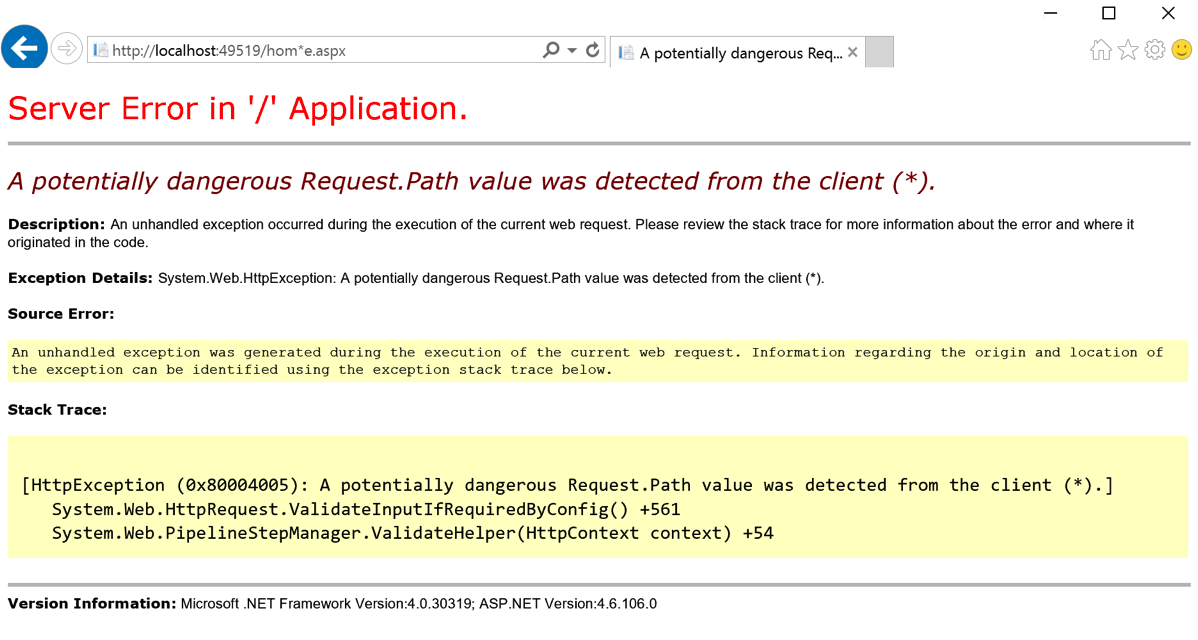
The screen above occurred because I placed the (*) character in the URL. In ASP.Net, there is a default set of defined illegal characters in the URL. This list is defined by RequestPathInvalidCharacters and can be configured in the web.config file. By default, the following characters are blocked:
- <
- >
- *
- %
- &
- :
- \\
It is important to note that these characters are blocked from being included in the URL, this does not include the protocol specification or the query string. That should be obvious since the query string uses the & character to separate parameters.
There are not many cases where your URL needs to use any of these default characters, but if there is a need to allow a specific character, you can override the default list. The override is done in the web.config file. The below snippet shows setting the new values (removing the < and > characters:
<httpruntime requestPathInvalidCharacters="*,%,&,:,\\"/>
Be aware that due the the web.config file being an xml file, you need to escape the < and > characters and set them as < and > respectively.
Remember that modifying the default security settings can expose your application to a greater security risk. Make sure you understand the risk of making these modifications before you perform them. It should be a rare occurrence to require a change to this default list. Understanding the platform is critical to understanding what is and is not being protected by default.
Static Analysis: Analyzing the Options
Filed under: Development, Security, Testing
When it comes to automated testing for applications there are two main types: Dynamic and Static.
- Dynamic scanning is where the scanner is analyzing the application in a running state. This method doesn’t have access to the source code or the binary itself, but is able to see how things function during runtime.
- Static analysis is where the scanner is looking at the source code or the binary output of the application. While this type of analysis doesn’t see the code as it is running, it has the ability to trace how data flows the the application down to the function level.
An important component to any secure development workflow, dynamic scanning analyzes a system as it is running. Before the application is running the focus is shifted to the source code which is where static analysis fits in. At this state it is possible to identify many common vulnerabilities while integrating into your build processes.
If you are thinking about adding static analysis to your process there are a few things to think about. Keep in mind there is not just one factor that should be the decision maker. Budget, in-house experience, application type and other factors will combine to make the right decision.
Disclaimer: I don’t endorse any products I talk about here. I do have direct experience with the ones I mention and that is why they are mentioned. I prefer not to speak to those products I have never used.
Budget
I hate to list this first, but honestly it is a pretty big factor in your implementation of static analysis. The vast options that exist for static analysis range from FREE to VERY EXPENSIVE. It is good to have an idea of what type of budget you have at hand to better understand what option may be right.
Free Tools
There are a few free tools out there that may work for your situation. Most of these tools depend on the programming language you use, unlike many of the commercial tools that support many of the common languages. For .Net developers, CAT.Net is the first static analysis tool that comes to mind. The downside is that it has not been updated in a long time. While it may still help a little, it will not compare to many of the commercial tools that are available.
In the Ruby world, I have used Brakeman which worked fairly well. You may find you have to do a little fiddling to get it up and running properly, but if you are a Ruby developer then this may be a simple task.
Managed Services or In-House
Can you manage a scanner in-house or is this something better delegated to a third party that specializes in the technology?
This can be a difficult question because it may involve many facets of your development environment. Choosing to host the solution in-house, like HP’s Fortify SCA may require a lot more internal knowledge than a managed solution. Do you have the resources available that know the product or that can learn it? Given the right resources, in-house tools can be very beneficial. One of the biggest roadblocks to in-house solutions is related to the cost. Most of them are very expensive. Here are a few in-house benefits:
- Ability to integrate directly into your Continuous Integration (CI) operations
- Ability to customize the technology for your environment/workflow
- Ability to create extensions to tune the results
Choosing to go with a managed solution works well for many companies. Whether it is because the development team is small, resources aren’t available or budget, using a 3rd party may be the right solution. There is always the question as to whether or not you are ok with sending your code to a 3rd party or not, but many are ok with this to get the solution they need. Many of the managed services have the additional benefit of reducing false positives in the results. This can be one of the most time consuming pieces of a static analysis tool, right there with getting it set up and configured properly. Some scans may return upwards of 10’s of thousands of results. Weeding through all of those can be very time consuming and have a negative effect on the poor person stuck doing it. Having a company manage that portion can be very beneficial and cost effective.
Conclusion
Picking the right static analysis solution is important, but can be difficult. Take the time to determine what your end goal is when implementing static analysis. Are you looking for something that is good, but not customizable to your environment, or something that is highly extensible and integrated closely with your workflow? Unfortunately, sometimes our budget may limit what we can do, but we have to start someplace. Take the time to talk to other people that have used the solutions you are looking at. Has their experience been good? What did/do they like? What don’t they like? Remember that static analysis is not the complete solution, but rather a component of a solution. Dropping this into your workflow won’t make you secure, but it will help decrease the attack surface area if implemented properly.
A Pen Test is Coming!!
Filed under: Development, Security, Testing
You have been working hard to create the greatest app in the world. Ok, so maybe it is just a simple business application, but it is still important to you. You have put countless hours of hard work into creating this master piece. It looks awesome, and does everything that the business has asked for. Then you get the email from security: Your application will undergo a penetration test in two weeks. Your heart skips a beat and sinks a little as you recall everything you have heard about this experience. Most likely, your immediate action is to go on the defensive. Why would your application need a penetration test? Of course it is secure, we do use HTTPS. No one would attack us, we are small. Take a breath.. it is going to be alright.
All too often, when I go into a penetration test, the developers start on the defensive. They don’t really understand why these ‘other’ people have to come in and test their application. I understand the concerns. History has shown that many of these engagements are truly considered adversarial. The testers jump for joy when they find a security flaw. They tell you how bad the application is and how simple the fix is, leading to you feeling about the size of an ant. This is often due to a lack of good communication skills.
Penetration testing is adversarial. It is an offensive assessment to find security weaknesses in your systems. This is an attempt to simulate an attacker against your system. Of course there are many differences, such as scope, timing and rules, but the goal is the same. Lets see what we can do on your system. Unfortunately, I find that many testers don’t have the communication skills to relay the information back to the business and developers in a way that is positive. I can’t tell you how may times I have heard people describe their job as great because they get to come in, tell you how bad you suck and then leave. If that is your penetration tester, find a new one. First, that attitude breaks down the communication with the client and doesn’t help promote a secure atmosphere. We don’t get anywhere by belittling the teams that have worked hard to create their application. Second, a penetration test should provide solid recommendations to the client on how they can work to resolve the issues identified. Just listing a bunch of flaws is fairly useless to a company.
These engagements should be worth everyone’s time. There should be positive communication between the developers and the testing team. Remember that many engagements are short lived so the more information you can provide the better the assessment you are going to get. The engagement should be helpful. With the right company, you will get a solid assessment and recommendations that you can do something with. If you don’t get that, time to start looking at another company for testing. Make sure you are ready for the test. If the engagement requires an environment to test in, have it all set up. That includes test data (if needed). The testers want to hit the ground running. If credentials are needed, make sure those are available too. The more help you can be, the more you will benefit from the experience.
As much as you don’t want to hear it, there is a very high chance the test will find vulnerabilities. While it would be great if applications didn’t have vulnerabilities, it is fairly rare to find them. Use this experience to learn and train on security issues. Take the feedback as constructive criticism, not someone attacking you. Trust me, you want the pen testers to find these flaws before a real attacker does.
Remember that this is for your benefit. We as developers also need to stay positive. The last thing you want to do is challenge the pen testers saying your app is not vulnerable. The teams that usually do that are the most vulnerable. Say positive and it will be a great learning experience.
ViewStateUserKey: ViewStateMac Relationship
Filed under: Development, Security, Testing
I apologize for the delay as I recently spoke about this at the SANS Pen Test Summit in Washington D.C. but haven’t had a chance to put it into a blog. While I was doing some research for my presentation on hacking ASP.Net applications I came across something very interesting that sort of blew my mind. One of my topics was ViewStateUserKey, which is a feature of .Net to help protect forms from Cross-Site Request Forgery. I have always assumed that by setting this value (it is off by default) that it put a unique key into the view state for the specific user. Viewstate is a client-side storage mechanism that the form uses to help maintain state.
I have a previous post about ViewStateUserKey and how to set it here: https://jardinesoftware.net/2013/01/07/asp-net-and-csrf/
While I was doing some testing, I found that my ViewState wasn’t different between users even though I had set the ViewStateUserKey value. Of course it was late at night.. well ok, early morning so I thought maybe I wasn’t setting it right. But I triple checked and it was right. Upon closer inspections, my view state was identical between my two users. I was really confused because as I mentioned, I thought it put a unique value into the view state to make the view state unique.
My Problem… ViewStateMAC was disabled. But wait.. what does ViewStateMAC have to do with ViewStateUserKey? That is what I said. So I started digging in with Reflector to see what was going on. What did I find? The ViewStateUserKey is actually used to modify the ViewStateMac modifier. It doesn’t store a special value in the ViewState.. rather it modifies how the MAC is generated to protect thew ViewState from Parameter Tampering.
So this does work*. If the MAC is different between users, then the ViewState is ultimately different and the attacker’s value is different from the victim’s. When the ViewState is submitted, the MAC’s won’t match which is what we want.
Unfortunately, this means we are relying again on ViewStateMAC being enabled. Don’t get me wrong, I think it should be enabled and this is yet another reason why. Without it, it doesn’t appear that the ViewStateUserKey doesn’t anything. We have been saying for the longest time that to protect against CSRF set the ViewStateUserKey. No one has said it relies on ViewStateMAC though.
To Recap.. Things that rely on ViewStateMAC:
- ViewState
- Event Validation
- ViewStateUserKey
It is important that we understand the framework features as disabling one item could cause a domino effect of other items. Be secure.



